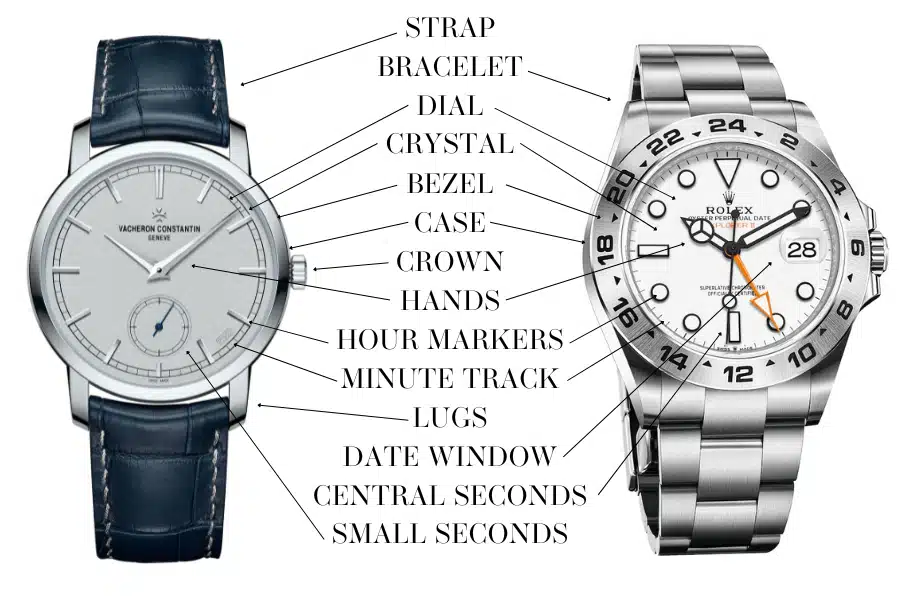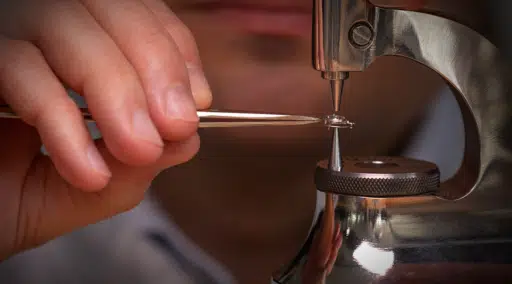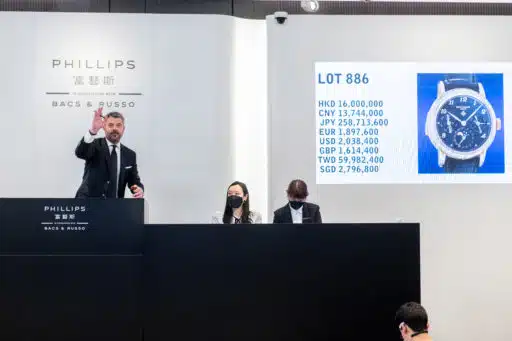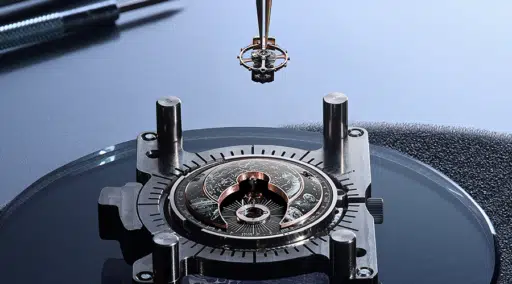The Watch Glossary
Horological terms can be confusing. Our watch glossary answers all of your questions.

Learning about watches is a fun but sometimes frustrating process. There are many specialized terms not used in other industries, and we use French words, too. The watch glossary covers the most common watch terminology questions. If there’s something we haven’t answered, check out our movement and complications section or our guide to the different types of watches and métiers d’art. Of course, we’re always happy to answer your questions, so shoot us an email if you can’t find the information you’re looking for.

The Watch Glossary
A
Analog Watch
An analog watch displays the time using a traditional clock face with hour and minute hands.
Anglage
See Chamfering
Antimagnetic
There are many magnetic sources that can interfere with a watch’s movement by magnetizing it, meaning the components won’t work as freely. This negatively affects the watch’s accuracy. Today, many watch brands use components made from nonmagnetic materials, such as silicon, to avoid magnetizing the movement.
Aperture
An aperture is an opening in the dial, also called a window, that displays information. Apertures are frequently used to tell the day or date in calendar watches.
Arabic Numerals
The numbers 0 to 12 are Arabic numerals. Their counterpart would be Roman numerals, which use letters instead of numbers.
ATM
ATM is a unit of atmospheric pressure. It is used to describe a watch’s water-resistance — i.e., how deep underwater a watch can go before the case could leak.
Automatic Movement
An automatic movement uses a rotor to self-wind the watch when the watch is in motion, either on the wrist or on a watch winder.
B
Balance Wheel
A balance wheel is the beating heart of the watch and regulates timekeeping. It is the equivalent of a pendulum on a clock. It is also called the balance.
Barrel
A barrel contains the mainspring, which provides the power to a watch movement.
Bezel
A bezel is a ring that secures the sapphire crystal (the clear crystal that covers the dial) in place. A bezel can be fixed in one position, bidirectional, or unidirectional. Some bezels include information, such as the time scale on a dive watch.
Bicompax
A bicompax watch has two subdials in the center of the dial. It’s a frequent dial design in chronograph watches. One shows the watch’s running seconds, and the other is a 30- or 60-minute subdial for measuring elapsed time.
Bracelet
A bracelet is a metal band that encircles the wrist and secures the watch. If it is made of leather or fabric, it is called a strap.
Breguet Hands
Abraham-Louis Breguet, one of the most important watchmakers of all time, designed thin hands with open circles shaped like a moon near the tip in the 18th century. Many watch brands still use Breguet hands for their elegant look.
Breguet Numerals
Abraham-Louis Breguet designed Arabic numerals with calligraphy-inspired flourishes in the 18th century. They remain a classic to this day, and many other brands, including Patek Philippe, frequently use Breguet numerals in their watches.
Bridge
A bridge secures the components that make up a movement.
C
Caliber
A caliber is a watch movement, the mechanism that powers the watch. Brands frequently name their movements Caliber ###.
Case
A watch case contains the movement and the dial. While most watch cases are round, cases come in many different shapes. Learn more about watch case shapes here.
Caseback
The back of a watch case. It can be made from solid metal or sapphire glass to display the movement. This is called an open caseback or an exhibition caseback.
Central Seconds
A watch with a long, thin seconds hand.
Chamfering
Chamfering is a finishing technique on watch movements. It is a symmetrical sloping angle on the edge of a component that adds visual contrast to the flat surface. Anglage is the French word for “chamfering.”
Chapter Ring
A circular ring on the dial that displays hours and minutes using numerals or markers is called a chapter ring.
Chronograph
A chronograph is a watch that tells the time and also functions as a stopwatch capable of timing elapsed time at events. Learn more about chronograph watches here.
Chronometer
A chronometer is an ultraprecise watch. Its average daily rate can be -4/+6 seconds per day, meaning it can be no more than four seconds faster or six seconds slower than the reference time every 24 hours. Brands can certify their watches on their own or use an independent third party, like COSC. Learn more about chronometer watches here.
Complication
A complication is any additional function on a watch other than telling the time. Examples of complications are: automaton, calendar, chronograph, jumping hours, minute repeater, moon phase, retrograde, tourbillon, travel time, and world timer.
Corrector
A corrector is a small button integrated into a watch case that controls a complication, such as a date. Typically, you’ll need a tool to press the corrector without scratching the case. Correctors can be finicky to use, so many brands use discreet pushers instead.
COSC
COSC is an abbreviation for the Contrôle Officiel Suisse des Chronomètres (Official Swiss Chronometer Testing Institute, in English). This independent organization tests and verifies the accuracy of chronometer watches, the name for ultraprecise watches. Watches that pass its tests can be called a COSC-certified chronometer. Learn more about chronometer watches here.
Côtes de Genève
Côtes de Genève is a finishing technique that looks like engraved stripes.
Counter
See Subdial
Crown
The crown is the knob on the side of a watch case. It typically appears at 3 o’clock. The crown manually winds the watch and sets the time. If the watch has additional complications, the crown can pull out into different positions to set the complications.
Crystal
A luxury watch has a sapphire crystal that covers the dial. This crystal protects the watch from water and dust. Many watches also have a sapphire crystal on the back of the watch that showcases the movement, as well. This is called an exhibition caseback.
Cyclops Lens
A magnifier on a sapphire crystal, frequently placed over the date. This is a hallmark of Rolex timepieces.
D
Deployant Buckle
A deployant buckle or clasp connects a watch strap or bracelet with a metal mechanism. It allows you to open, close, and adjust the watch without unbuckling it. It can extend the life of leather and fabric straps because you set the pin in the appropriate hole in the strap once instead of every time you wear it. Many consider a deployant buckle to be safer than a traditional pin buckle (like a belt buckle), while others find it cumbersome and annoying to use on leather or fabric straps.
Dial
The dial displays the time. On the majority of watches, the dial covers the front of the watch. Some watches have small, off-center dials and use the rest of the surface for métiers d’art. The dial is sometimes called the face, but “dial” is the preferred industry term.
Digital
A digital watch displays the time using numbers instead of hands. While most digital watches are electronic, there are some mechanical watches that feature digital displays, including the Zeitwerk watch from A. Lange & Söhne.
Dive Watch
A dive watch is water-resistant and meets certain requirements to ensure a diver’s safety. Learn more here.
E
Escapement
The escapement provides controlled energy to the balance wheel by regularly suspending the motion of the wheels.
Exhibition Caseback
See Open Caseback
F
Face
See Dial
Finishing
Finishing is the term used to describe the polishing and decorations on watch components, particularly the movement. Hand finishing is a hallmark of the best luxury watch brands. The French term is ‘finissage.’
Flyback Chronograph
A flyback chronograph allows you to reset and restart the chronograph timer with one push, instead of stopping, resetting, and restarting the chronograph.
G
Geneva Seal
See Poinçon de Genève
Geneva Strips
See Côtes de Genève
GMT
A GMT watch has two central hour hands: one for the local time, and a long one that tells time in a second time zone on a 24-hour scale.
Grande Complication
A grande complication watch has several coveted complications, such as a minute repeater, split-seconds chronograph, and perpetual calendar.
Guilloché
Guilloché, also called engine turning, is a type of decorative engraving used on watch dials and components. Learn more about guilloché here.
H
Hand-wound
See Manual Movement
Hands
Hands are long pieces of metal that indicate the time. Nearly all watches have hour and minute hands. Hands can also be used to display the seconds and other functions, including the date, day of the week, week number, and power reserve.
Horology
Horology is the science of measuring time and the creation of clocks and watches.
Hour Markers
Also called indices, hour markers are used in place of numerals on a dial.
I
In-house Movement
An in-house movement is developed, created, and assembled by a watch brand in its manufacture.
Indices
Indices are markers used in place of numerals to indicate hours or minutes on a dial.
J
Jewels
Jewels are synthetic gemstones used in a watch movement to reduce friction between the moving parts. Most commonly, they are synthetic rubies.
Jumping Hours
Jumping-hour watches use a combination of disks and apertures, instead of hands, to show the time. Learn about jumping-hour watches here.
L
Lugs
Lugs extend from the watch case and secure the bracelet or strap to the case.
Luminosity
Manufactures coat certain dial components — including hands, hour markers, and time scales — with a luminescent coating to improve visibility in the dark. These coatings have a gentle glow so you can tell the time underwater or at night.
M
Mainspring
A mainspring powers a watch movement. When you wind a mechanical watch, you are tightly coiling the mainspring and storing energy. As it unwinds, it releases power. The mainspring is contained in the mainspring barrel.
Manual Movement
A manual movement is a mechanical watch movement without an electronic battery. It is powered by winding the movement, typically by turning the crown.
Manufacture
A manufacture is a factory or workshop that makes watches.
Mechanical Watch
A mechanical watch is powered without the use of a battery by using springs, gears, and other components.
Métiers d’Art
There are many different types of métiers d’art in watchmaking. These are artistic crafts, including enameling, engraving, guilloché, and painting. Learn about métiers d’art here.
Micro-rotor
A micro-rotor is a small semicircular weight that spins and winds the movement. Brands use micro-rotors to achieve thinness, as they are integrated into the movement instead of mounted above it, like a traditional rotor.
Minute Repeater
A minute repeater is a chiming watch that strikes the hours, quarter hours, and minutes. Learn more here.
Monopusher
A monopusher combines multiple chronograph pushers into one. A monopusher is frequently integrated into the crown.
Moon Phase
A moon-phase watch shows the current phase of the lunar cycle, typically with an artistic subdial. Learn more about moon-phase watches here.
Movement
A movement is the mechanism that powers a watch. It can be quartz (powered by a battery) or mechanical (powered solely by mechanical components).
N
NATO Strap
A NATO strap is a single piece of material that secures the watch to the wrist. It differs from a traditional watch strap, which is typically made of two separate pieces. NATO straps are usually made from a ribbed fabric, although they can come in other materials, including leather. Many dive and sports watches feature NATO straps.
O
Open Caseback
An open caseback is transparent, allowing you to see the watch’s movement. Instead of having a solid metal caseback, an open caseback is made from clear sapphire crystal. It is sometimes called an exhibition caseback.
Oscillating Weight
See Rotor
P
Perpetual Calendar
A perpetual calendar accurately tells the date, including leap years, if the watch is kept wound. In French, it is called quantième perpetual, or QP for short.
Poinçon de Genève
The Poinçon de Genève, the Geneva Seal, is a certificate for watches with the finest quality and finishings. The independent body has strict criteria for provenance, craftsmanship, and precision.
Power Reserve
The power reserve is the number of hours of power stored in the mainspring — i.e., the length of time a watch will run without winding. Once the power reserve is depleted, the watch will stop. Discover the watches with the longest power reserves here.
Power-reserve Indicator
A power-reserve indicator displays how much power is left in the watch movement. It can appear on the dial or on the back of the watch.
Pusher
A pusher is a button on a watch that controls a complication. Chronograph watches use pushers to start and stop the timer. Some watches use pushers to adjust complications, including travel watches and world timers.
Q
Quartz Watch
A quartz watch uses a battery as its primary power source.
R
Register
See Subdial
Retrograde
A retrograde hand moves in an arc and returns to its original position once it reaches the end instead of making a full circle. Retrograde displays can be used to tell hours, minutes, seconds, the date, or the power reserve. Learn more about retrograde watches here.
Roman Numerals
Roman numerals use letters as numbers. In horology, the numbers 1 through 12 are shown as: I, II, III, IV, V, VI, VII, VIII, IX, X, XI, and XII.
Rotor
A rotor is a semicircular weight in a watch movement. As the watch moves — on a wrist or on a watch winder — the rotor spins and winds the mainspring, powering the watch.
S
Screw-in Crown
Many dive watches have screw-in crowns that can improve a watch’s water-resistance. A screw-in crown must be unscrewed before it can be adjusted.
Signature
A signature is the watch brand’s name on the dial.
Skeleton Watch
A skeleton watch showcases the watch’s movement by eliminating the dial or using a small one so that internal workings are visible. Learn more about skeleton watches here.
Small Seconds
A watch that shows the seconds in a small subdial instead of with a central hand
Split-seconds Chronograph
A split-seconds chronograph has two central chronograph hands that can simultaneously time two events that end at different moments.
Strap
A strap is a piece of leather or fabric that wraps around the wrist and secures a watch in place. If it is made of metal, it is called a bracelet.
Subdial
A subdial is a small dial within the main dial of a watch. A watch can contain multiple subdials that display different types of information. A subdial is also called a counter or register, particularly in chronograph watches.
Sweeping Seconds Hand
True to its name, a sweeping seconds hand gracefully turns around the dial without noticeable jumps or ticks.
T
Tachymeter
A tachymeter scale is on the bezel of a watch, frequently seen on chronograph watches. You can use the tachymeter scale to calculate speed based on how long it takes to travel a known distance.
Tourbillon
A tourbillon compensates for the negative effects of gravity on a watch’s precision. Learn more about tourbillon watches here.
U
Unidirectional Rotating Bezel
This type of bezel turns in only one direction. This makes it popular in dive watches, which frequently contain a scale used for timing the length of a dive on the bezel. Since a unidirectional rotating bezel moves in only one direction, you can’t accidentally extend your dive time by turning it the wrong way.
W
Water-Resistance
Water is the main enemy of a watch movement, so having a water-resistant case is important, even in everyday watches. However, not all watches are water-resistant, especially complicated or gem-set watches. A watch’s water-resistance is critical in dive watches. It is measured in meters, bar, or atmospheres.
Wesselton Diamonds
Top Wesselton diamonds and Wesselton diamonds are colorless or near-colorless diamonds. They are the equivalent of F, G, or H color diamonds, but watch brands frequently use the Wesselton grading system instead.
Wheels
Wheels are components in a watch movement. There are several types of wheels in a movement, each with a different function.






